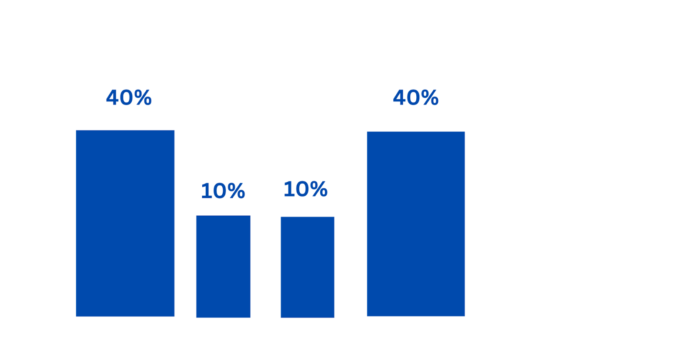If the limitations of single-touch attribution models are hindering the efficacy and reach of your digital marketing efforts, it may be time to transition to a more dynamic option — the position-based attribution model. Join us below as we explore the concept of the methodology, including the advantages it provides over traditional models.
What Is Position-Based Attribution?
Also referred to as U-shaped attribution, the position-based attribution model assigns the majority of the credit for a conversion to the first and last touchpoints, thus representing the two pinnacles of the “U” shape.
The interactions that occur between the first and last touchpoints also receive a portion of the credit, with those that are closest to the first and last exchanges receiving more credit than those that lie in the middle, forming the downward dip of the model’s “U” shape.
As an example, let’s say that a customer interacts with your brand a total of five times. Under the position-based attribution model, the first and last touchpoints might each receive 35% of the credit, the second and second-to-last touchpoints might each be assigned 12% of the credit, and the middle interaction would receive just 5% of the credit.
The Shortcomings of Single-Touch Attribution
Before we get into the benefits of position-based attribution, it’s important to consider the problem that a single-touch approach — be it first-touch or last-touch — presents.
Under the first-touch model, a consumer’s initial interaction with your brand receives 100% of the credit for their eventual conversion, regardless of how many follow-up exchanges occur before the customer makes a purchase; conversely, the last-touch model assigns 100% of the credit for a conversion to the final touchpoint. Again, it doesn’t matter how many times a customer interacted with your brand; that one touchpoint still receives full credit.
The reason why that becomes a problem is that anything that happens before or after the primary interaction goes unaccounted for. In the first-touch model, the initial exchange is viewed as paramount to the conversion, and though that may be true, other interactions will have undoubtedly contributed to a customer’s purchasing decision. The last-touch model’s problem is the opposite; it minimizes the value of everything other than the final exchange between your brand and the customer.
Why Position-Based Attribution Works
Position-based attribution works because it accounts for the complexity of the modern consumer journey. On average, a customer will interact with your brand eight separate times before making a purchase; with the position-based model, you’ll be able to assign conversion credit to each of these touchpoints.
The position-based model also recognizes that the first and last conversions are still of utmost importance. Without the first interaction, customers wouldn’t be aware of your brand in the first place, and if not for the final interaction, they may not have taken the leap and made their purchase.
At the same time, the position-based model supplements the argument that each of the middle interactions spurred the customer along and kept them interested in your product.
Benefits of Position-Based Attribution
The position-based attribution model provides several benefits on top of distributing credit among multiple touchpoints. Such advantages and perks include the following:
A Better Understanding of the Customer Journey
Position-based attribution sheds light on the entire customer journey, allowing you to see which channels and strategies are most effective at various stages of the funnel. Once you understand the customer journey, you’ll be able to optimize it.
Informed Budgeting Capabilities
By understanding the value of each touchpoint in the customer journey, you can strategically allocate your marketing budget to maximize your ROI. You will be able to focus on the channels that truly drive conversions and shift money away from less effective mediums.
Enhanced Customer Insights
The U-shaped model offers deeper insights into customer behavior, allowing your team to tailor your strategy to meet consumers where they are most receptive.
For instance, you may discover that your Facebook and connected TV ads are most impactful among your target audience; in turn, you’ll be able to make these channels mainstream components of your marketing strategy.
Agility in Marketing Decisions
With a clearer understanding of what influences your audience, you can quickly adapt your marketing strategies to capitalize on those elements, and if a channel suddenly becomes less effective, you’ll be able to pivot to more impactful touchpoints to keep the leads flowing.
Is It Time to Adopt the Position-Based Attribution Model?
The position-based attribution model is a strategic tool that, when used effectively, can unlock new levels of success in digital marketing by offering a better understanding of the nuanced and complicated conversion journey of modern consumers. While it may not be the ideal fit for every business, it does represent a clear upgrade for many organizations that is certainly worth exploring.





